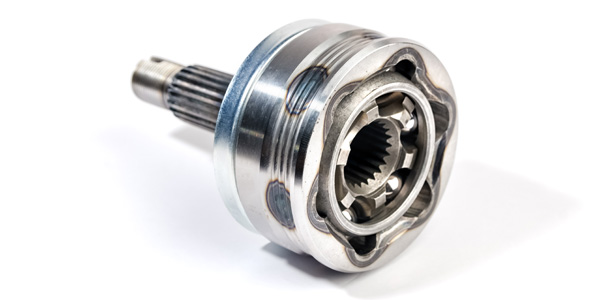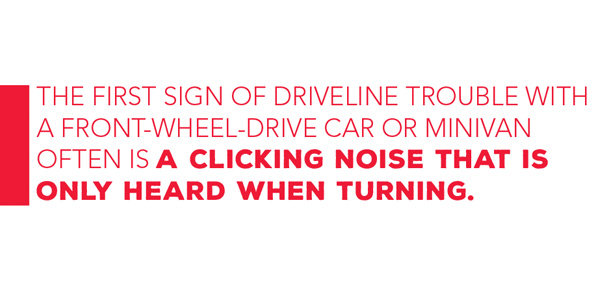
The first sign of driveline trouble with a front-wheel-drive car or minivan often is a clicking noise that is only heard when turning. An outer constant velocity (CV) joint that is worn or damaged will produce this kind of sound. Another complaint might be a clunk from under the vehicle when putting an automatic transmission into drive or reverse, or a high-speed vibration that is not due to tire imbalance. Either of these conditions may signal a failing inner CV joint (although a bad motor/transmission mount can make the same kind of clunks and vibrations).
Another reason why CV joints and halfshafts may require replacing is when the protective boots that surround the inner and outer CV joints are leaking, torn, loose or missing altogether. The boots keep dirt and water out while keeping the grease in. A boot failure means the joint will soon lose its grease and probably become contaminated by road splash, dirt and grit. Either way, it’s going to be the end of the road for the vulnerable CV joint.
Replacing a CV joint boot or a bad CV joint requires removing the halfshaft from the vehicle. Getting the shaft out usually requires a hub-puller tool of some type to separate the outer CV joint from the hub. Once the shaft has been removed, it can either be rebuilt or replaced.
Diehard penny pinchers will often opt to replace a bad boot or CV joint rather than buy a whole new or reman shaft. Yes, they can save some bucks by replacing only the individual components that have obviously failed. But ask anybody who has done this job more than once and they will tell you a complete halfshaft assembly is a LOT faster and easier to install, and it’s well-worth the difference in price.
Complete halfshaft assemblies come with new boots installed, and are available with either new or remanufactured CV joints. Replacing a CV joint or boot is a messy job, and if you don’t use the correct grease (special CV joint grease only, never ordinary chassis grease!) or don’t get the boot clamps installed correctly, the boot may leak or come loose.

Another reason for replacing the entire shaft rather than just a bad boot or joint is that the boot and joint on the other end of the shaft may be nearing the end of their service life too – especially on older, high-mileage (more than 100,000 miles) vehicles. Why take a chance reusing old parts when a new shaft can restore the driveline to like-new condition? Considering the labor that’s involved to remove and reinstall a halfshaft, why not do the job once and be done with it?
A lot of all-wheel-drive SUVs use halfshafts both front and rear, and some rear-wheel-drive cars also use halfshafts in the rear. The inner and outer CV joints on rear halfshafts tend to be much longer-lived than the outer CV joints up front because the rear wheels don’t steer. The joints experience less bending so there is less internal friction and wear. However, they are just as vulnerable as the CV joints up front to boot failures. And just like front CV joints, a boot failure is bad news for the longevity of the joint, even if the leaky boot is discovered before the joint runs dry. It doesn’t take much loss of lubricant or outside contamination to permanently damage the steel balls and grooves inside a CV joint. Once there is play or pitting in these components, the joint is doomed.
Related items that also may be required when changing a halfshaft include fasteners and new hub nuts. The wheel bearings also should be closely inspected for play or roughness and replaced as needed.









